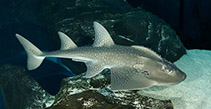Rhina ancylostomus Bloch & Schneider, 1801
Bowmouth guitarfish
Add your observation in Fish WatcherAquaMaps webservice down at the moment
Classification / Names Nomi Comuni | Sinonimi | Catalog of Fishes(Genere, Specie) | ITIS | CoL | WoRMS | Cloffa
Elasmobranchi (squali e razze) (sharks and rays) > Rhinopristiformes (Shovelnose rays) > Rhinidae (Wedgefishes)
Etymology: Rhina: Greek, rhinos = nose (Ref. 45335).
More on authors: Bloch & Schneider.
Etymology: Rhina: Greek, rhinos = nose (Ref. 45335).
More on authors: Bloch & Schneider.
Issue
Spelling following ECoF.
Environment: milieu / climate zone / depth range / distribution range Ecologia
marino associati a barriera corallina; distribuzione batimetrica 3 - 90 m (Ref. 30573). Tropical; 42°N - 34°S, 30°E - 170°E (Ref. 114953)
Distribuzione Stati | Aree FAO | Ecosystems | Presenze | Point map | Introduzioni | Faunafri
Indo-West Pacific: Persian Gulf (Ref. 68964), Red Sea and East Africa to Papua New Guinea, north to Japan, south to New South Wales, Australia.
Length at first maturity / Size / Peso / Age
Maturity: Lm 164.0, range 150 - 178 cm
Max length : 300 cm TL maschio/sesso non determinato; (Ref. 58784); peso massimo pubblicato: 135.0 kg (Ref. 9987)
Max length : 300 cm TL maschio/sesso non determinato; (Ref. 58784); peso massimo pubblicato: 135.0 kg (Ref. 9987)
Short description Chiavi di identificazione | Morfologia | Morfometria
An unmistakable guitarfish with a broad, rounded snout, large, high pectoral fins, and heavy ridges of spiky thorns over the eyes and on the back and shoulders; jaws with heavily ridged, crushing teeth in undulating rows (Ref. 5578). Grey or brownish above (Ref. 5578), white below; numerous white spots dorsally on fins, body and tail; black spots on head and shoulders but no eyespots or ocelli (Ref. 3919).
Inhabits coastal areas and on coral reefs, close inshore (Ref. 9915). Found on sand and mud bottoms (Ref. 12951). Sometimes found in the water column (Ref. 12951). Feeds mainly on bottom crustaceans and mollusks (Ref. 9915). Ovoviviparous (Ref. 50449). Produces litters of 2-11 pups (Ref. 114953). A row of large spines present above the eye, on the center of the nape, and on the shoulder have a defensive function (can be used for butting). Caught commonly by demersal tangle net, and occasionally trawl and longline fisheries (Ref.58048). Difficult to handle and can damage the catch when caught in trawls (Ref. 9915). Utilized fresh and dried-salted; the pectoral fins are the only part which is eaten (Ref. 9987).
Life cycle and mating behavior Maturità | Riproduzione | Deposizione | Uova | Fecundity | Larve
Exhibit ovoviparity (aplacental viviparity), with embryos feeding initially on yolk, then receiving additional nourishment from the mother by indirect absorption of uterine fluid enriched with mucus, fat or protein through specialised structures (Ref. 50449). With 4 in a litter (Ref. 12951). Size at birth 45 cm (Ref. 12951).
Main reference
Upload your references | Bibliografia | Coordinatore | Collaboratori
Compagno, L.J.V. and P.R. Last, 1999. Rhinidae (=Rhynchobatidae). Wedgefishes. p. 1418-1422. In K.E. Carpenter and V. Niem (eds.) FAO identification guide for fishery purposes. The Living Marine Resources of the Western Central Pacific. FAO, Rome. (Ref. 9915)
IUCN Red List Status (Ref. 130435: Version 2024-2)
Critically Endangered (CR) (A2bd); Date assessed: 03 December 2018
Threat to humans
Other (Ref. 637)
Human uses
Pesca: commerciale
FAO - Publication: search | FishSource |
Informazioni ulteriori
Population dynamics
Growth parameters
Max. ages / sizes
Length-weight rel.
Length-length rel.
Length-frequencies
Mass conversion
Reclutamento
Abbondanza
Growth parameters
Max. ages / sizes
Length-weight rel.
Length-length rel.
Length-frequencies
Mass conversion
Reclutamento
Abbondanza
Life cycle
Riproduzione
Maturità
Maturity/Gills rel.
Fecundity
Deposizione
Spawning aggregations
Uova
Egg development
Larve
Dinamica popolazioni larvali
Riproduzione
Maturità
Maturity/Gills rel.
Fecundity
Deposizione
Spawning aggregations
Uova
Egg development
Larve
Dinamica popolazioni larvali
Anatomy
Area branchiale
Brain
Otolith
Area branchiale
Brain
Otolith
Physiology
Body composition
Nutrients
Oxygen consumption
Swimming type
Swimming speed
Visual pigments
Fish sound
Diseases & Parasites
Toxicity (LC50s)
Body composition
Nutrients
Oxygen consumption
Swimming type
Swimming speed
Visual pigments
Fish sound
Diseases & Parasites
Toxicity (LC50s)
Genetics
Genetica
Heterozygosity
Ereditarietà
Genetica
Heterozygosity
Ereditarietà
Human related
Aquaculture systems
Profili di acquacoltura
Varietà
Ciguatera cases
Stamps, coins, misc.
Aquaculture systems
Profili di acquacoltura
Varietà
Ciguatera cases
Stamps, coins, misc.
Strumenti
E-book | Giuda pratica | Chiavi di identificazione | Generatore frequenze di lunghezza | Strumento Parametri Biologici | Mappa dei ritrovamenti | Classification Tree
| Catch-MSY |
Special reports
Download XML
Fonti Internet
AFORO (otoliths) | Aquatic Commons | BHL | Cloffa | BOLDSystems | Websites from users | Check FishWatcher | CISTI | Catalog of Fishes: Genere, Specie | DiscoverLife | ECOTOX | FAO - Publication: search | Faunafri | Fishipedia | Fishtrace | GenBank: genome, nucleotide | GloBI | Google Books | Google Scholar | Google | IGFA World Record | MitoFish | Database Nazionali | Otolith Atlas of Taiwan Fishes | PubMed | Reef Life Survey | Socotra Atlas | Tree of Life | Wikipedia: Go, ricerca | World Records Freshwater Fishing | Zoobank | Zoological Record
Estimates based on models
Preferred temperature (Ref. 123201): 24.4 - 29.1, mean 28.1 °C (based on 1422 cells).
Phylogenetic diversity index (Ref. 82804): PD50 = 1.0010 [Uniqueness, from 0.5 = low to 2.0 = high].
Bayesian length-weight: a=0.00372 (0.00163 - 0.00845), b=3.11 (2.91 - 3.31), in cm total length, based on LWR estimates for this (Sub)family-body shape (Ref. 93245).
Trophic level (Ref. 69278): 3.6 ±0.50 se; based on food items.
Resilienza (Ref. 120179): Molto basso, tempo minimo di raddoppiamento della popolazione più di 14 anni (Fec=4).
Fishing Vulnerability (Ref. 59153): Very high vulnerability (90 of 100).
Nutrients (Ref. 124155): Calcium = 6.66 [1.37, 27.05] mg/100g; Iron = 0.311 [0.072, 0.881] mg/100g; Protein = 19.5 [17.3, 21.6] %; Omega3 = 0.0694 [, ] g/100g; Selenium = 45.3 [13.9, 139.1] μg/100g; VitaminA = 26.1 [8.3, 82.9] μg/100g; Zinc = 0.722 [0.351, 1.434] mg/100g (wet weight);




